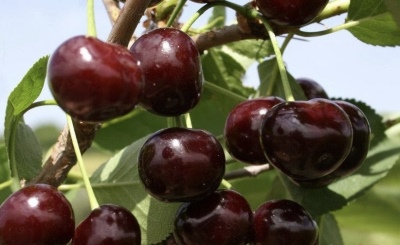
- Authors: Kolesnikova A.F., Dzhigalo E.N., Gulyaeva A.A., Mosina R.V.
- Year of approval: 2013
- Barrel type: wood
- Growth type: medium-sized
- Crown: weeping, drooping, medium density
- Escapes: medium, arcuate, brownish-brown, glabrous
- Leaves: obovate, short-pointed, light green, wrinkled, matte
- Flowers: medium, pink, white
- Fruit size: average
- Fruit shape: one-dimensional, rounded
Putinka ordinary cherry is a relatively new variety that attracts attention with good yield, versatility of fruits in application, good marketability and consumer properties. The plant is perfect for use in landscape design, very decorative even outside the flowering period due to the unusual shape of the crown.
Breeding history
The variety has been presented in the State Register of the Russian Federation since 2013, it was included in it after passing tests. The selection was carried out by specialists of the All-Russian Research Institute of Breeding of Fruit Crops. During hybridization, we used Anthracitovaya and Excellent Venyaminova cherries.
Description of the variety
A tree with a very beautiful weeping crown grows up to 3 m in height. The shoots are medium thickened, have a short length, arched, painted in a brown-brown tone. The branches are bare, not pubescent, the leaves are light green, with characteristic wrinkles, without shine. During the flowering period, the shoots are covered with pink-shaped white buds, exuding a delicate aroma. Putinka's stem is strong, straight, of medium diameter, slightly widening towards the roots.
Fruit characteristics
Cherries are medium in size, on long petioles, each weighing up to 5.6 g. Fruits are round, uniform, well-sized. Fruits and pulp are intensely dark red. The stone is medium inside, it separates well from the pulp. For transportation, you need to remove the cherries a little earlier, 1-3 days before they are fully ripe, then they will tolerate transportation well.
Taste qualities
Putinka fruits have a rather high tasting score - 4.6 points. The taste of cherries is sweet and sour, dessert, very pleasant, juicy pulp, medium density, brightly colored juice. The variety is perfect for processing, freezing, preparation for the winter in the form of jam or compotes.
Ripening and fruiting
Fruiting in this cherry begins 4 years after planting. The ripening time of the fruits is average, the harvest is carried out in late July - early August. Cherries do not fall off the branches as they ripen, they are resistant to baking in the sun. You can harvest as it ripens, not at the same time.

Yield
When grown in orchards, the predicted average yield of the variety is 79.9 c / ha.
Growing regions
Cherry is thermophilic. Putinka can be grown in the conditions of the Central Black Earth Region. It is also well adapted to the temperate climatic zone. In the northern regions, Putinka freezes in winter without shelter.
Self-fertility and the need for pollinators
The variety is partly self-fertile, but pollinators are needed to get really bountiful yields.It will be enough if a suitable cherry variety is found in the neighboring garden. In this capacity, Zhukovskaya, Kharitonovskaya, and also Iput cherries can act. The plant blooms in May, the budding period takes 7-14 days.
Landing
For planting Putinka cherries, you need to choose sunny, very well-lit areas. Protection from the wind is optional, but the hill should be erected artificially if there is no way to remove the plants away from groundwater in another way. Autumn planting is possible in the south. But in regions of a temperate climatic zone, it is better to choose spring for these purposes, from the 2nd decade of April.


Growing and care
Putinka is a rather unpretentious variety. She needs to organize moderate watering along the contour of the near-stem circle, bringing in about 10-15 liters at a time, but only in extreme heat. Moisturize the root zone in the evening. Watering completely stops 2 weeks before harvesting.
Abundant tree feeding is not required. Seasonal organic matter, bird droppings, or manure can be added periodically. A not too dense crown grows poorly. If it begins to thicken at the trunk, pruning is carried out, shortening the shoots to 40 cm. Sanitary removal of diseased and fertile branches is performed in the fall.


Disease and pest resistance
Putinka belongs to cherries that are relatively resistant to the development of diseases and pests. The tree is well protected from fungi. Practically does not get sick even in damp and humid climates. The variety is resistant to moniliosis, coccomycosis. This combination is unusual, practically not found in other varieties of cherries, therefore Putinka is of particular interest to both gardeners and professional agronomists.
Requirements for soil and climatic conditions
Winter hardiness of this variety is good, shoots and fruit buds do not freeze without shelter when atmospheric temperatures drop to -35 degrees. Trees grow well in fertile, well-drained soils. The variety is relatively resistant to drought; with a short-term establishment of heat, it does without increasing the irrigation rate. High temperature combined with a lack of moisture is dangerous only during flowering, as well as during the formation of fruits.

Review overview
Despite the fact that Putinka appeared on the domestic garden market relatively recently, many summer residents have already managed to harvest more than one crop from it. The fruits are rated the highest, they are tasty and sweet, and the sourness, according to reviews, is not felt too much. Gardeners point to the complete hassle-free care - the tree requires minimal attention to itself, tolerates the vagaries of the weather well, does not grow too much.
Putinka has quite a few downsides. The tree practically does not get sick, it grows well. The only drawback is the tendency of ripe fruits to damage. They are recycled as soon as possible so as not to be crushed during storage.































































